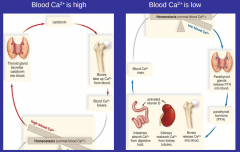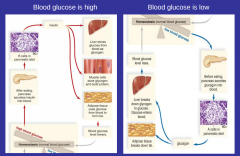![]()
![]()
![]()
Use LEFT and RIGHT arrow keys to navigate between flashcards;
Use UP and DOWN arrow keys to flip the card;
H to show hint;
A reads text to speech;
45 Cards in this Set
- Front
- Back
|
exocrine glands |
have ducts and secrete their products into these ducts |
|
|
endocrine glands |
secrete their products into the bloodstream, which delivers th em thoughout the body |
|
|
hypothalamus |
an endocrine organ and the highest hormone secretion control center, its hormones either promote or inhibits other hormones releases |
|
|
target cell (endocrine system) |
cells that have the unique receptors for one kind of hormone molecules to bind, the organ containing these target cells are called target organ |
|
|
peptide hormones |
most endocrine glands secrete peptide hormones. proteins, peptides, amino acids, they bind to receptors on the plasma membrane and cause the activation of a series of intracellular events (enzyme chain reaction). often called first messenger |
|
|
steroid hormones |
can directly enter cells because they are lipids. binds to receptor, usually in nucleus, binds with DNA and activates certain genes. increase gene transcription, promotes protein synthesis. slower response, but prolonged action (compared with peptide hormones) |
|
|
Pituitary gland |
divided into anterior and posterior lobs. controls hormone release form all the glands below (except pineal gland) |
|
|
antidiuretic hormone (ADH) |
regulates water balance by reabsorbing water into the bloodstream |
|
|
oxytocin |
causes uterine contractions during childbirth. allows milk to be released during breast-feeding |
|
|
thyroid gland |
produces thyroid hormone: regulates metabolism and calcitonin: helps lower blood Ca2+ levels by stimulating the deposition of calcium in the bones |
|
|
simple goiter |
thyroid enlarges due to lack of iodine in the diet |
|
|
regulation of blood Ca2+ (+/- homeostasis) |

|
|
|
adrenal glands |
composed of adrenal medulla: short-term stress response (epinephrine, norepinephrine) and adrenal cortex: long-term stress response |
|
|
insulin |
secreted by the B cells in the pancreas when blood glucose level is high (usually after eating). stimulates the uptake of glucose by cells, especially liver cells, muscle cells and adipose tissues cells. |
|
|
glucagon |
secreted by the A cells in the pancreas when blood glucose is low and stimulates the breakdown of glycogen in the liver. also promotes the use of fat and protein in preference to glucose as energy sources |
|
|
regulation of blood glucose |

|
|
|
pineal gland |
secretes melatonin that regulates the sleep/wake cycle. may also regulate sexual development |
|
|
arteries |
lead blood away from the heart. from large to small: aorta, arteries, arterioles |
|
|
capillaries |
smallest blood vessels for material exchange walls have only one layer of endothelium, many gaps on the walls |
|
|
veins |
carry blood away form the capillaries and move it towards the heart. from large to small: veins, venules |
|
|
describe passage of blood through heart |
- the superior vena cava and the inferior vena cava carry oxygen-poor blood from the body veins to the right atrium. - the right atrium contracts (simultaneously with the left atrium), sending blood through an atrioventricular valve (the tricuspid valve) to the right ventricle) - the right ventricle contracts, pumping blood through the pulmonary semilunar valve into the pulmonary trunk. the pulmonary trunk, which carries oxygen-poor blood, divides into two pulmonary arteries, which go to the lungs. - pulmonary capillaries within the lungs allow gas exchange. oxygen enters the blood; carbon dioxide waste is excreted from the blood - four pulmonary veins, which carry oxygen-rich blood, enter the left atrium - the left atrium pumps blood through an atrioventricular valve (the bicuspid valve) to the left ventricle - the left ventricle contracts (at the same time as the right ventricle), sending blood through the aortic semilunar valve into the aorta - arteries and arterioles supply tissue capillaries. tissue capillaries drain into increasingly larger veins. Veins drain into the superior and inferior venae cavae, and the cycle starts again |
|
|
Sinus Atrial (SA) node |
principle cardiac pacemaker located under the right atrial wall, it initiates cardiac contraction |
|
|
AV node |
relays the electrical pulses, sends the pulses along the Purkinje fibers to cause the ventricular muscle to contract |
|
|
highest blood velocity is in the ________. lowest blood velocity is in the _________. |
aorta, capillaries |
|
|
Which are thicker, arteries or veins? Why |
arteries, because much higher pressure |
|
|
elements of blood |
red blood cells/erythrocytes (no nucleii) & white blood cells/leukocytes & platelets (45%), plasma (55%) |
|
|
What do red blood cells carry? |
can carry oxygen, carbon dioxide, carbon monoxide |
|
|
hemoglobin |
RBCs contain hemoglobin, a pigment with a high affinity for oxygen |
|
|
How do RBCs transport carbon dioxide? |
some dissolved in plasma, some carried in hemoglobin, and the rest transported as bicarbonate ion |
|
|
antigen |
a cell or other substance foreign to the individual that invokes an immune response |
|
|
lymphatic system functions |
(1) lymphatic capillaries absorb excess interstitial fluid and return it to the bloodstream (2) in the small intestines, lymphatic capillaries called lacteals absorb fats in the form of lipoproteins and transport them to the bloodstream (3) the lymphatic system is responsible for the production, maintenance, and distribution of lymphocytes (4) the lymphatic system helps defend the body against pathogens |
|
|
virus |
small, non-living cellular parasites, no metabolic mechanisms. acellular, do not have nucleus, organelles. |
|
|
primary lymphatic organs |
red bone marrow, thymus |
|
|
T cells |
pathogen fighting cells that mature in the thymus |
|
|
B cells |
pathogen fighting cells that mature in the bone marrow |
|
|
Secondary lymphatic organs |
spleen, lymph nodes, tonsils, appendix |
|
|
lymph |
interstitial fluid: mostly water, but also contains solutes derived from plasma. contains cellular products |
|
|
spleen |
contains red and white pulp. blood entering the spleen must pass through the sinuses before exiting. here, macrophages that are like powerful vacuum cleaners engulf pathogens and debris, such as worn-out red blood cells |
|
|
lymph nodes |
occur along lymphatic vessels and filter lymph. b y engulfing pathogens and debris. lymphocytes are also present here, and fight infections and attack cancer cells. |
|
|
innate defenses |
two categories. physical barriers (skin, tears, saliva, mucous membranes, etc) and chemical barriers (secretions of the oil glands, chemicals in saliva, acidic pH of stomach and vagina, etc) |
|
|
prions |
infections protein particles. cause degenerative disease of the nervous system |
|
|
What is the pathway that food follows? |
mouth -> pharynx -> esophagus -> stomach -> small intestine -> large intestine -> rectum -> anus |
|
|
Where does carbohydrate digestion start? |
In the mouth via amylase |
|
|
where does the digestion of proteins start? |
stomach, where gastric juice, which contains the enzyme pepsin, breaks down proteins and gastric acid (HCI) and mucus |
|
|
where does fat digestion start? |
in the intestines via bile that is secreted by the gallbladder |

